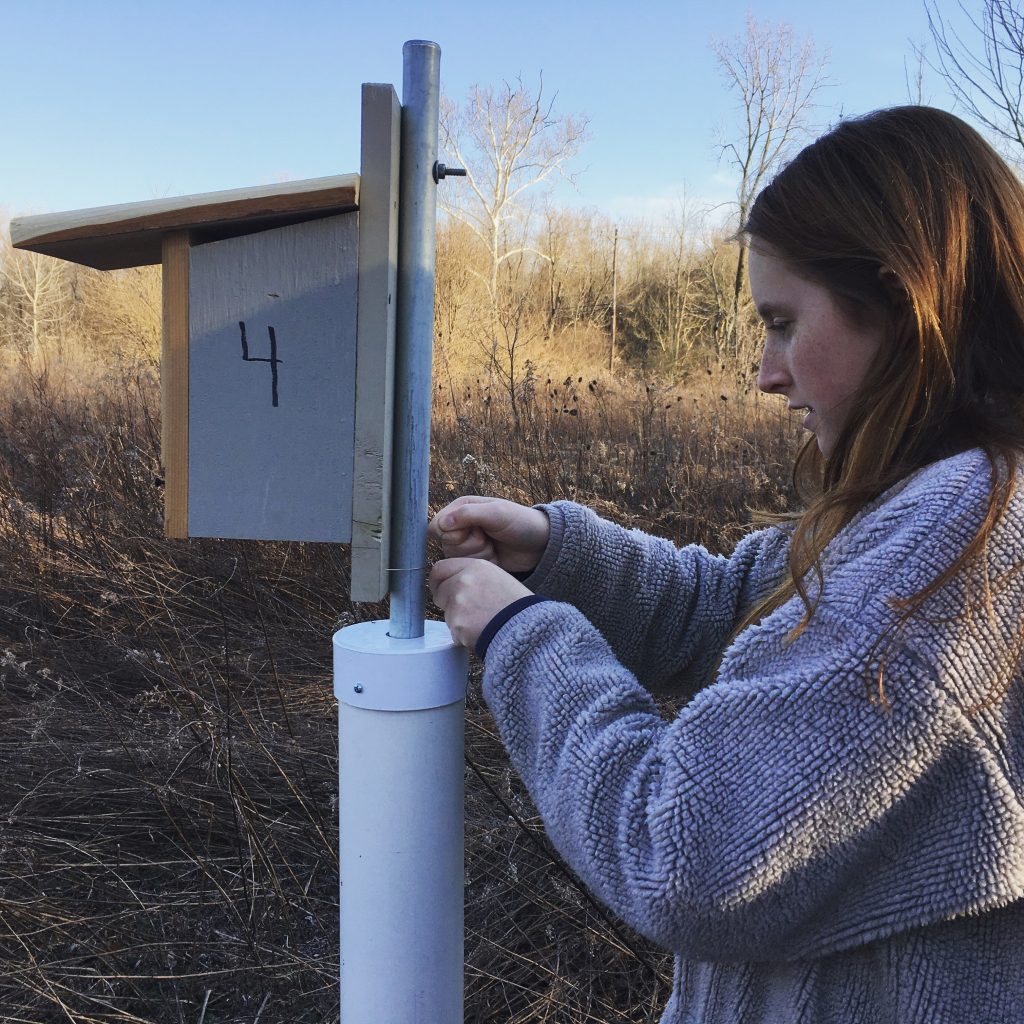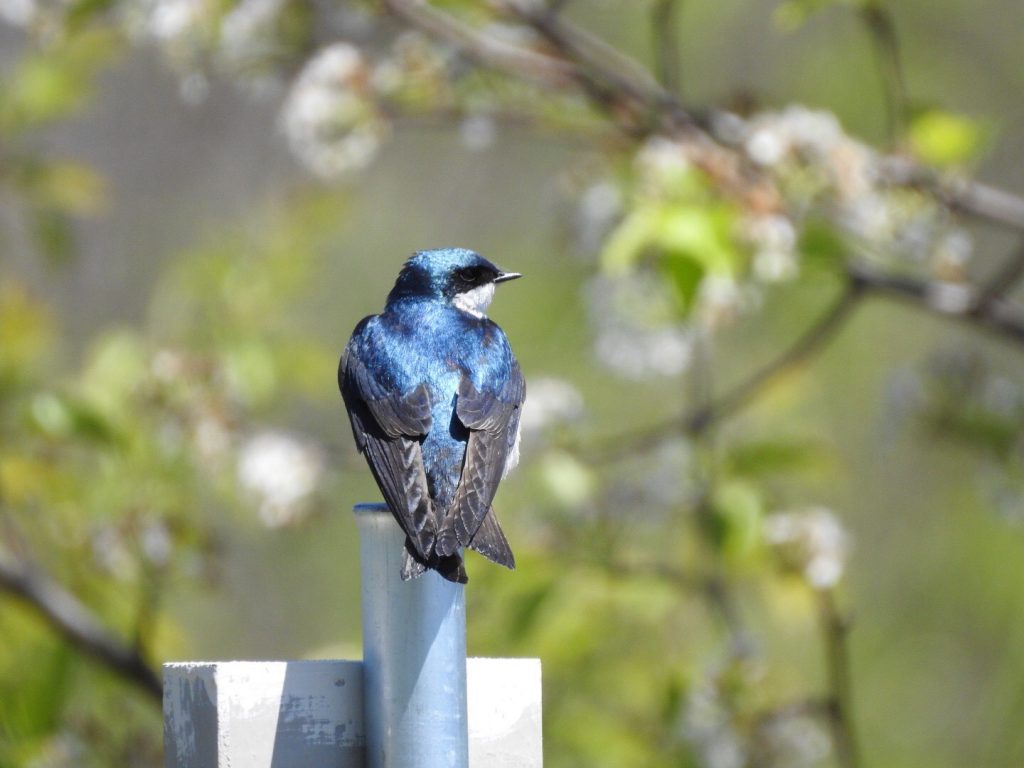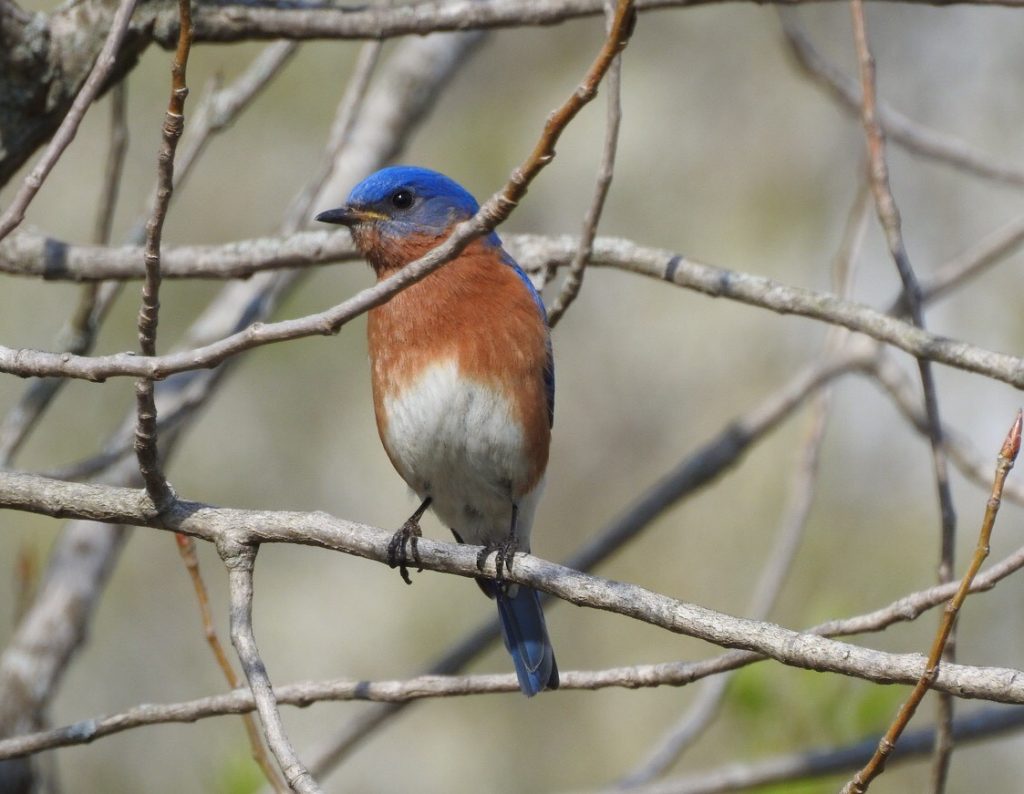New Homes For Birds On The Walnut River
May 17, 2018By Katelyn Shelton (age 14), Ohio Young Birders Club

One Chilly Day In March
With help from my family and Darlene (Ohio Young Birders Club advisor), we installed a nest box trail in my neighborhood.
Just Passing Through
It was a chilly day in March when I and my family, with my good friend Darlene, set up the boxes. The Big Walnut Trail, which I fondly nicknamed “The Loop,” is down the street from my house, right behind my neighborhood, nestled between the houses and the Walnut River. The center of The Loop was mostly a mixture of meadow and shrubs, and on the west side, which was bordered by the river, was a beautiful deciduous forest. It was a good place for a variety of birds. Despite this variety The Loop usually gets, Eastern Bluebirds have never been a resident there. Sure, they would pass through maybe twice a year, but they never stayed.
My bluebird trail and its boxes, however, changed that. Not only did I attract Eastern Bluebirds to The Loop, but I was pleasantly surprised with Carolina Chickadees in the box that I had put in my backyard. Almost immediately after I saw them going in and out of the box, my father and I ran to the store to purchase a hole reducer so that the House Sparrows wouldn’t be a problem. The chickadees continued bringing mouthfuls of moss and strips of bark. About two weeks later, they had eggs. I was so happy!
On Tree Swallows and Wasps

Tree Swallows Showed Up in Numbers
Tree Swallows clamored to claim their boxes, sometimes sparring in mid-air while the females looked on.
As the temperatures warmed and the weather looked more optimistic, a flock of about seven Tree Swallows showed up. Right away they took to box three, the males sparring in mid-air and the females peeking inside the box. Some even landed on the ground to get small twigs; most of them were small, that is. One male grabbed such a large stick it was poking through the hole of the box, and it twitched and shook as he tried to fit it inside. He was successful in the end; good for him!
After the swallows had their excitement with box three, they all took off for box four. There, the same process was underway; or so I thought. It wasn’t until my next nest check that I realized what had really been going on. Wasps. There were about fifteen of them. I jumped back in surprise when I opened it for I had been expecting a nest underway. I tried pushing them out with a stick, but there were so many, they either did a u-turn back into the box or, in some cases, charged at me. It was spooky, I admit. I knew I wasn’t going to get far with the method I was using. I reasoned that the wasps wanted a safe, enclosed space, so I decided to leave the box open and take a walk. It worked—by the time I got back, they had all disappeared! Soon, the Tree Swallows were going in and out of the recently infested box. I was so proud of myself, battling the scary wasps for the birds.
At Last, A Bluebird!

Eastern Bluebird Male Visits The Loop
This male Eastern Bluebird made me freeze in my tracks!
It was around 8:30am when I saw the Eastern Bluebirds for the first time. I froze in my tracks when I saw the male, a brilliant blue puff ball in a bush. He gave me a quick, wary look, then flew down the trail and turned a corner. He had seemingly disappeared. I continued walking, and from a safe distance, concealed by brush, I spotted him again in a leafless tree near the nest box. I took out my binoculars and watched. After a few moments of the male hunting close to my box, the female darted into view, disappearing into the nesting box. This was all I needed to see, and jumped for joy. I practically skipped home, my smile stretching from ear to ear. I had managed to bring Eastern Bluebirds to The Loop!
Now, the Eastern Bluebird nest and Tree Swallow nests are underway, while a Carolina Chickadee snuggles into hers and keeps her eggs warm and toasty. The bluebird trail had enriched my birding experience, and enriched the habitat around my neighborhood. In fact, the trail made me more adventurous, exploring the areas around my house to know what birds were there. In that process, I found a Cooper’s Hawk nest, a Red-bellied Woodpecker cavity, two American Robin nests, and one Mourning Dove nest. All of these nests were highly active, and I am now able to observe the different nesting behaviors of these species, which is truly beautiful. And I owe all of it to my bluebird trail.

10 comments on “New Homes For Birds On The Walnut River”
I loved the story of success,I am hoping to do the same someday.
Thank you for sharing your story, Katelyn! I, too, have found that monitoring nest boxes has inspired me to observe other species of birds and their nesting behaviors. Because of my nest boxes, I have become a better birder and a more observant hiker.
What a wonderful thing you have done for the birds – you should be very proud. I wish you a successful nesting season!
Wow! A very well written story Katelyn. I can tell you know your birds and love learning. Keep it up girl and you could go far.
uncle JS
Beautifully written Katelyn and your photos are gorgeous! This is an inspiring story and I am so glad that you shared it with the NestWatch community!
I love c hickadees! : ) yay
Congratulations on your bluebird success. I too had bluebirds nesting for about three successive years until wrens discovered the boxes, and ever since they have destroyed the bluebird nests and eggs. You may want to discourage the wrens from your boxes.
Great, encouraging story! Some tips from many years of nest monitoring for Cornell U.: Get a book (or computer app) that identifies bird eggs to better i.d. whose nest you’ve found. Get an old style car side mirror from a junk yard and screw it to a long pole. You can use it to check nests higher off the ground. Shine a flash light up into the mirror and you can see into low light nests. I have used a house sparrow nest box trap for years to reduce local numbers – very effective early in the nesting season. Get them up early where you can check them easily. Seldom is a non-target bird caught and they can be released unharmed. Make them the same as your other nest boxes so if a pair of house sparrows takes over one of the boxes it can be replaced with the trap box. My experience is you’ll get the pair in one or two days because they want “their” box. [House sparrows are not protected by the Migratory Treaty Act or any other law so should be euthanized.]
And a comment: In North Dakota I saw tree swallows harassing a pair of W. bluebirds and very likely ran them off from a nest box. They are aggressive little jewels!
You rock, Katelyn! You captured beautifully how I felt when I first started my bluebird trail.
I was lucky enough to meet Katelyn at a family gathering. What a lovely person she is. And she writes like a dream. Katelyn has so much to offer the world of birds – and all of us who appreciate them. Thanks, Katelyn, and looking forward to more!
Awesome job on getting the hole reducer for the lil chickadees…I did the same five years ago and have had successful families since..only good sparrow is a dead sparrow..cheers from New Jersey!